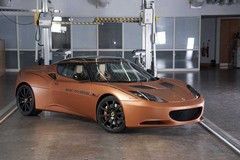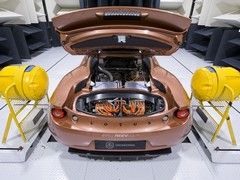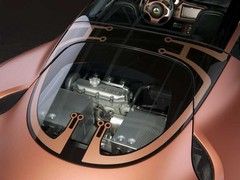Lotus Evora 414E: the tech
A geek's guide to the technology underpinning Lotus's clever range extender Evora, driven recently by PH

Background
In 2006, the Labour Government created the Technology Strategy Board to boost manufacturing innovation in the UK and fund projects that demonstrated this. The 414E is one of these, part of a joint effort between the TSB, Lotus, Jaguar, Infiniti, Xtrac and Evo Electric. It aims to establish a supply base of EV vehicle components in the UK, with smaller companies such as Evo Electric benefitting from the corporate power of the larger partners whilst imparting their expertise.
Range-extender engine
The 414E is different to the Vauxhall Ampera and Toyota Prius Plug-In as its internal combustion engine was designed specifically as a range-extender only, as opposed to borrowing a conventional engine. This means it can be optimised to work only at the speed required to power the generator (3,500rpm), making it more efficient. The Lotus range-extender is a 1.2-litre three-cylinder with 48hp and tri-fuel (petrol, methanol and ethanol) capability. It utilises Lotus's new mono block design, incorporating the block, head and exhaust manifold into one unit. This makes it lighter (51kg) and smaller, which is crucial when you see it crammed in amongst the elctronics in the back of an Evora.
The Evora's range-extender (a prototype whose construction differs slightly from the production version) is modular, which allows parts to be added or taken away without significant internal modifications. Already a supercharged version with 68hp exists for higher-performance installations, whilst a two-cylinder also exists to be used where space is at a premium.
Battery pack
Sitting in place of the rear seats in the Evora 414E, the battery pack weighs 250kg and is rated at 14.9kWh. It comprises 1,780 lithium ion battery cells. Predictably, the charging of these batteries produces a huge amount of heat so there are four cooling pumps to ensure they remain at optimum temperature. A lot of time was invested in a battery management system to support the cooling and also ensure recharging takes place at the correct time.
At present, the range-extender will automatically assist the batteries when they have around 35 per cent charge level remaining. At 100 per cent, the EV range is 30 miles, whilst draining it and the 30-litre fuel tank of the range-extender gives a total range figure somewhere near 300 miles. CO2 emissions are rated at 55g/km
Generator
The generator comes from British firm Evo Electric. It is driven straight off the crank of the range-extender, which saves on weight and cost.
Electric motors
Two synchronous axial flux drive motors also from Evo Electric power the Evora 414E, delivering 207hp and 369lb ft each. They are charged through four inverters (which are the four silver rectangular boxes in the images) and channel power to the road through an Xtrac single-speed transmission. Lotus has invested heavily in ensuring accurate torque distribution between each wheel, meaning that torque vectoring will feature in future developments of the 414E.
I think 30 miles is enough to cover most commutes, anyway.
ETA: According to the government, the average commute length in the UK is 8.5 miles each way, so 30 mile electric-only range seems pretty well judged.
At the end of the day it has a mode that lets the car run of batteries "ONLY".Yes i know the tesla is battery only so would have more space for added capacity ,but the evoras range is still **** ,one lap around any major city in the country and that engine is firing back up.
thats why i say ,look at improving battery technology and go into the smaller suppliers.
At the end of the day it has a mode that lets the car run of batteries "ONLY".Yes i know the tesla is battery only so would have more space for added capacity ,but the evoras range is still **** ,one lap around any major city in the country and that engine is firing back up.
thats why i say ,look at improving battery technology and go into the smaller suppliers.
I guess there's no fundamental reason they shouldn't offer cars with various different sized battery packs.
I think 30 miles is enough to cover most commutes, anyway.
ETA: According to the government, the average commute length in the UK is 8.5 miles each way, so 30 mile electric-only range seems pretty well judged.
It makes sense as a project, 30miles to cover the commute/run to teh shop or school run, the range extender is there to let you get to LeMans in a normal manner.
I know there are all sorts of issues about the cost of electricity and how you make it, but this type of package isn't going to go away. Nice to see the Lotus name on it.
I think the batteries in a system like this should easily out-last the rest of the car. I suppose extremes of temperature might still hurt them.

Li-ions have pretty much an infinite life-span if treated properly. Certainly well into the tens of years as long as they aren't allowed to get too hot or left to discharge for months on end.
Still, it's closer to a Prius than a Tesla IMO, i.e. it's a hybrid, but turned around so that the electric motor is the primary motivator, not the combustion engine, and that gives it much better efficiency than the Prius (which I believe can only manage a fraction of the distance on battery power alone). So it gives you the range and practicality of a Prius but with better efficiency, and the power and torque delivery of the Tesla but with better range and practicality.
Even if you turn that on its head and say it's not as efficient as a Tesla, it still stands that this power unit seems to be a better way of doing hybrid than the Prius solution, with no relative drawbacks. So it trades punches with the Tesla but seems to win across the board against the Prius, powerplant wise at least.
Love the idea of an engine that has no head gasket to blow, great for turbo/supercharging opportunites, casting and machining this must have been a real challenge.
IMHO Rnage extenders are the way to go in the near/medium term. These work well for most situation when prolonged hard acceleration is not required (i.e. everyday motoring, sorry not very PH but a reality on today's conjested roads). The idea of a constant speed, ultra efficient petrol or diesel generator providing energy through a battery or capacitor buffer to electric motors makes sense.
In simplistic terms, if you draw a graph of power vs time for any journey the area under of the graph is the fuel required and this dividied by the time is the average power needed to complete the journey. If the buffer can then provide extra power for the spikes and regen breaking and the generator can fill in the dips in the graph you have a very efficient system.
I'd be interested to see this system with 2x100HP motors, capacitors rather than batteries in a small, lightweight car which should be very efficient and still pretty good to drive. Aim - car under 1250kg (being realistic), fiesta or S2000 size/shape, 200 HP, 300 ft lbs, 50+ mile range and 100 miles/gallon on a 100 mile journey of mixed real world driving (i.e. my commute !!!)and the same price as a mid range similar car (not the silly price that the Ampere is going for compared to a mid range Insignia, £37k vs £22k)
Out of interest, does anyone know whether this engine also has the electric valve actuation on it that Lotus were playing around with on the Rover K series a while back (I suspect not but would be intersting to see)?
And how much would it cost in electricity to charge the batteries for the first 30 miles?
Or put another way, 270 miles for 30 litres of fuel - how many mpg is that?
http://www.mpg-calculator.co.uk/
Love the idea of an engine that has no head gasket to blow, great for turbo/supercharging opportunites, casting and machining this must have been a real challenge.
This kind of tech is the way for electric cars really. At least until you can charge a battery to 300 miles range in 5 mins (comparable to filling up a normal car with petrol).
Gassing Station | General Gassing | Top of Page | What's New | My Stuff






